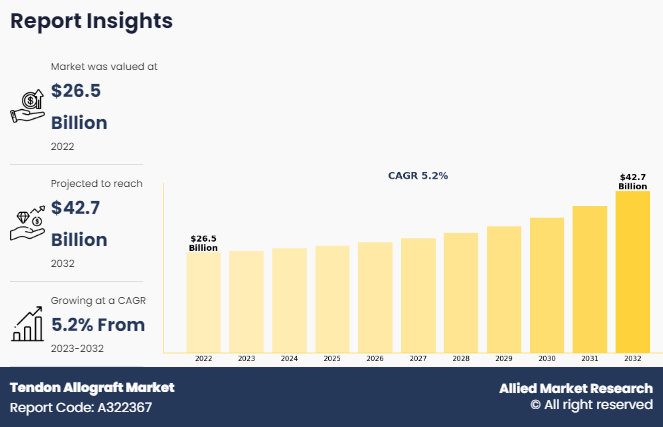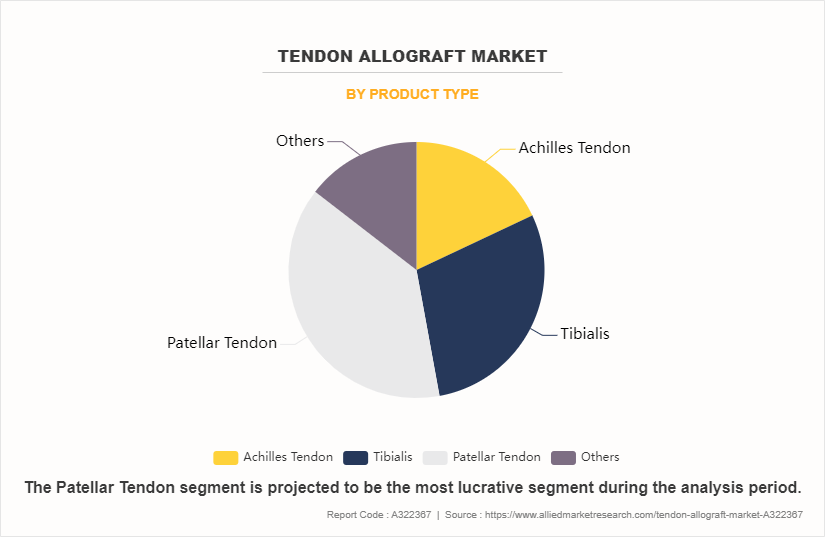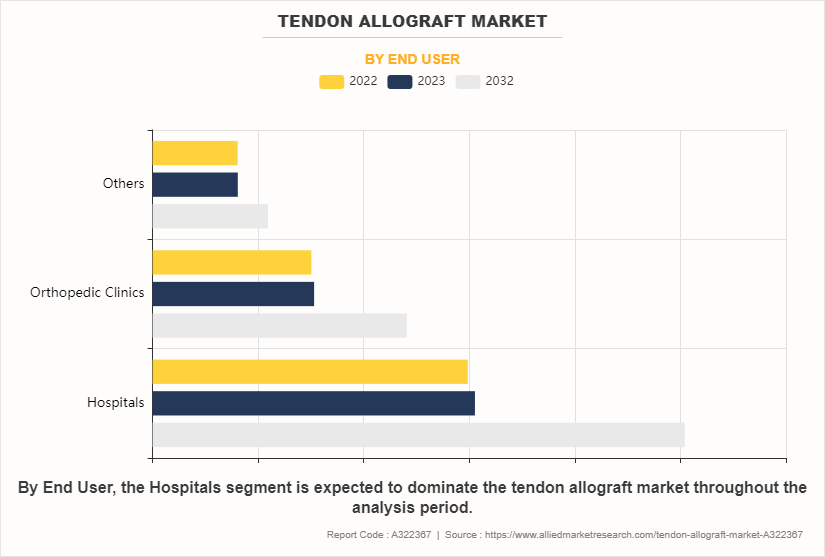Tendon Allograft Market Research, 2032
The global tendon allograft market size was valued at $26.5 billion in 2022, and is projected to reach $42.7 billion by 2032, growing at a CAGR of 5.2% from 2023 to 2032. Technological advancements in tendon allograft processing and preservation drive the market growth. Innovations in tissue preservation methods have extended the shelf life of tendon allografts, allowing for longer storage times without compromising tissue quality. This enables healthcare providers to maintain a ready supply of grafts for surgical procedures.

A tendon allograft is a surgical procedure where a tendon from a donor (usually a cadaver) is used to replace a damaged or torn tendon in a recipient. This type of procedure is common in orthopedic surgery, particularly for reconstructing torn ligaments in the knee, such as the anterior cruciate ligament (ACL) or the posterior cruciate ligament (PCL).
The term "allograft" refers to tissue or organ transplanted from one individual to another of the same species but with a different genetic makeup. In the case of a tendon allograft, the donor tendon is taken from a human cadaver, processed to remove cells and reduce the risk of rejection, and then transplanted into the recipient's body to repair the damaged tendon. This approach is often preferred over using the patient's own tendon (autograft) due to factors such as decreased surgical time and avoiding additional injury to the patient's own tissues.
Market Dynamics
Advances in sterilization techniques ensure the removal of pathogens and decrease the risk of infection associated with allograft transplantation. This improves the safety profile of the procedure and increases patient confidence in choosing allografts over other options. New processing methods aim to retain the biomechanical properties of tendons while reducing immunogenicity and the risk of graft rejection. These techniques may involve decellularization, which removes cellular components from the tissue, leaving behind a scaffold that promotes tissue regeneration when implanted. All these factors are anticipated to drive the tendon allograft market growth.
The demand for tendon allografts often exceeds the supply of available donor tissues. This can lead to shortages, longer wait times for patients in need of surgery, and increased pressure on healthcare systems to find alternative solutions. The pool of potential tissue donors is limited by factors such as population demographics, consent rates for tissue donation, and eligibility criteria for donors. For instance, not everyone is medically suitable to be a tissue donor, further narrowing the available pool of donor tissues.
Regulatory requirements surrounding tissue donation, processing, and transplantation can also impact the availability of donor tissues. Stringent regulations aim to ensure the safety and quality of allografts but may inadvertently limit the number of tissues that meet the criteria for transplantation.
Minimally invasive procedures & technological advancements drive the allograft tendon market opportunity. Patients often prefer minimally invasive procedures due to shorter recovery times, reduced postoperative pain, and lower risk of complications compared to traditional open surgeries. Surgeons are increasingly utilizing minimally invasive techniques for orthopedic procedures, including tendon reconstructions. These techniques involve smaller incisions, specialized instruments, and sometimes even arthroscopic guidance. All these factors are anticipated to drive the tendon allograft market opportunity in upcoming year.
Segments Overview
The tendon allograft industry is segmented on the basis of product type, end user and region. By product type, the market is sub-segmented into Achilles tendon, tibialis, patellar tendon, and others. By end user, the market is classified into hospitals, orthopedic clinics, and others. By region, the market is analyzed across North America, Europe, Asia-Pacific, and LAMEA.
By Product Type
The patellar tendon sub-segment dominated the tendon allograft market size in 2022. The patellar tendon has biomechanical properties that make it a preferred choice for anterior cruciate ligament (ACL) reconstruction. Its strong and durable nature provides stability and support, mimicking the function of the native ACL. Research studies have demonstrated favorable clinical outcomes associated with the use of patellar tendon allografts in ACL reconstruction. Factors such as graft survival, stability, and patient satisfaction contribute to the growing acceptance of this approach among surgeons and patients.
Many orthopedic surgeons have extensive experience and familiarity with using patellar tendon allografts for ACL reconstruction. Surgeon preference, based on factors such as surgical technique, graft availability, and outcomes, plays a significant role in driving the demand for patellar tendon allografts.

By End User
The hospitals sub-segment dominated the global tendon allograft market share in 2022. Hospitals with specialized orthopedic departments and experienced surgeons attract patients seeking treatment for tendon injuries. The reputation of a hospital for providing high-quality care and successful outcomes influences patient decisions regarding where to undergo surgery. Hospitals often invest in state-of-the-art surgical equipment and technologies to support minimally invasive procedures and advanced tissue processing techniques. Access to cutting-edge technology can enhance surgical precision, improve patient outcomes, and drive demand for allograft tendons.

By Region
North America dominated the global tendon allograft market share in 2022. North America has a high prevalence of sports-related injuries, including ACL tears, rotator cuff tears, and Achilles tendon ruptures. As participation in sports and physical activities continues to rise, there is a growing demand for tendon allografts for reconstructive surgeries among athletes and active individuals. North America is at the forefront of medical innovation, with ongoing advancements in tissue processing techniques, surgical instrumentation, and rehabilitation protocols. Innovative technologies such as minimally invasive surgical techniques, tissue engineering, and biologic augmentation contribute to the expansion of the tendon allograft market by improving surgical outcomes and patient recovery.

Regulatory agencies such as the Food and Drug Administration (FDA) in the United States ensure the safety, efficacy, and quality of allograft tissues used in surgical procedures. Compliance with regulatory standards is essential for market participants, fostering trust among healthcare providers and patients regarding the safety of allograft products.
Competitive Analysis
The key players profiled in this report include Aesculap, Lattice Biologics Ltd., MTF Biologics, LifeNet Health, Integra LifeSciences Corporation, RTI Surgical, Tissue Banks International, AlloSource, Arthrex, and Zimmer Biomet Holdings Inc. Investment and agreement are common strategies followed by major market players. For instance, In August 2022, orthopedic surgeons at University National Hospital performed the first meniscal transplant and implanted donor cartilage into a patient‐™s knee in Scotland.
Key Benefits for Stakeholders
- This report provides a quantitative analysis of the market segments, current trends, estimations, and dynamics of the tendon allograft market analysis from 2022 to 2032 to identify the prevailing tendon allograft market opportunities.
- The market research is offered along with information related to key drivers, restraints, and opportunities.
- Porter's five forces analysis highlights the potency of buyers and suppliers to enable stakeholders make profit-oriented business decisions and strengthen their supplier-buyer network.
- In-depth analysis of the tendon allograft industry segmentation assists to determine the prevailing market opportunities.
- Major countries in each region are mapped according to their revenue contribution to the global market.
- Market player positioning facilitates benchmarking and provides a clear understanding of the present position of the market players.
- The report includes the analysis of the regional as well as global tendon allograft market trends, key players, market segments, application areas, and market growth strategies.
- Based on product type, the patellar tendon sub-segment emerged as the global leader in 2022 and is anticipated to be the fastest growing sub-segment during the tendon allograft market forecast period.
Tendon Allograft Market Report Highlights
| Aspects | Details |
| Market Size By 2032 | USD 42.7 billion |
| Growth Rate | CAGR of 5.2% |
| Forecast period | 2022 - 2032 |
| Report Pages | 280 |
| By Product Type |
|
| By End User |
|
| By Region |
|
| Key Market Players | Tissue Banks International, MTF Biologics, Arthrex, Lattice Biologics Ltd., RTI Surgical, Zimmer Biomet Holdings Inc., Aesculap, AlloSource, Integra LifeSciences Corporation, LifeNet Health |
As the global population ages, the prevalence of age-related conditions such as tendon degeneration and tears increases. This demographic trend creates a larger pool of potential patients for tendon allograft procedures. Additionally, ongoing advancements in tissue processing and preservation technologies improve the quality and availability of tendon allografts. These innovations enhance the efficacy and safety of tendon transplant procedures.
The major growth strategies adopted by tendon allograft market players are investment and agreement.
Asia-Pacific is projected to provide more business opportunities for the global tendon allograft market in the future.
Aesculap, Lattice Biologics Ltd., MTF Biologics, LifeNet Health, Integra LifeSciences Corporation, RTI Surgical, Tissue Banks International, AlloSource, Arthrex, and Zimmer Biomet Holdings Inc. are the major players in the tendon allograft market.
The patellar tendon sub-segment of the product type acquired the maximum share of the global tendon allograft market in 2022.
The report provides an extensive qualitative and quantitative analysis of the current trends and future estimations of the global tendon allograft market from 2022 to 2032 to determine the prevailing opportunities.
Tendon allografts are commonly used in orthopedic surgeries for the repair and reconstruction of damaged tendons and ligaments, particularly in cases of sports injuries, trauma, and degenerative conditions such as osteoarthritis. Procedures such as anterior cruciate ligament (ACL) reconstruction, rotator cuff repair, and Achilles tendon repair frequently utilize tendon allografts.
Loading Table Of Content...
Loading Research Methodology...



